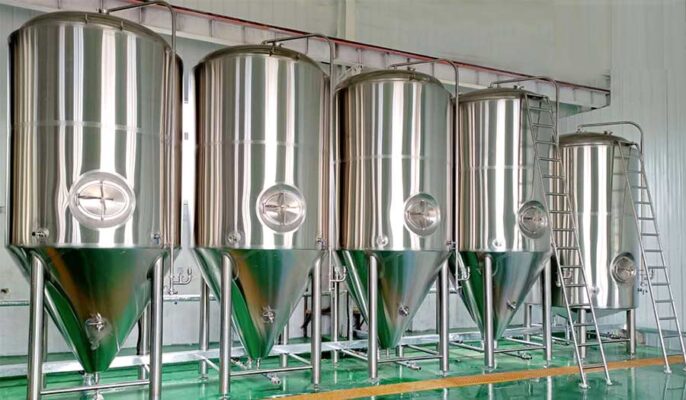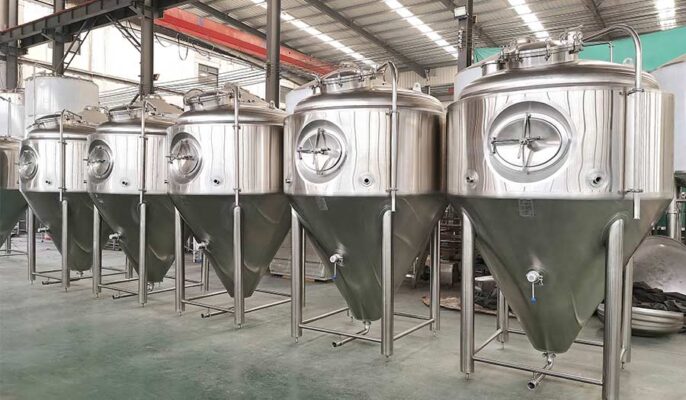Um fermentador é uma peça essencial do equipamento para qualquer pessoa interessada em fabricar cerveja, vinho ou fermentar outras bebidas ou alimentos. A principal função destes tanques é proporcionar um ambiente ótimo para os microrganismos de fermentação converterem o açúcar em álcool e outros subprodutos, produzindo assim o produto final desejado.
O que é um fermentador?
Tanques de fermentaçãoOs tanques de fermentação, também conhecidos como recipientes de fermentação, são recipientes especializados concebidos para o processo de fermentação em várias indústrias, especialmente na produção de bebidas alcoólicas, como a cerveja e o vinho. A principal função destes tanques é proporcionar um ambiente ótimo para os microrganismos fermentadores converterem o açúcar em álcool e outros subprodutos.
Caraterísticas das cubas de fermentação:
- Material: A maioria dos tanques de fermentação é feita de aço inoxidável, que tem uma excelente resistência à corrosão e é fácil de limpar. Isto garante a pureza e a qualidade do produto final.
- Controlo da temperatura: A fermentação é um processo sensível à temperatura. Os fermentadores modernos estão equipados com camisas de arrefecimento ou serpentinas internas para regular a temperatura.
- Ambiente selado: Para evitar a contaminação, o tanque de fermentação é selado. Este ambiente selado garante a qualidade consistente do produto final.
- Capacidade: Os tamanhos dos tanques variam de pequenos tanques caseiros de poucos galões a grandes tanques comerciais com capacidade para milhares de galões.

Tipos de fermentadores
Aberto cuba de fermentação
Um recipiente simples, sem tampa ou vedante, é o tipo mais básico de fermentador. São utilizados para fermentar o vinho porque permitem um acesso fácil e a prensagem manual da tampa (a camada de peles e grainhas de uva que sobe à superfície durante a fermentação).
Tanque de fermentação fechado
Os fermentadores fechados têm uma tampa selada que impede a entrada de quaisquer contaminantes externos no processo de fermentação. São utilizados no fabrico de cerveja porque protegem o líquido da exposição ao ar, que pode causar deterioração ou sabores estranhos.
Tanque de fermentação de capacidade variável
Os fermentadores de capacidade variável têm tampas flutuantes e volumes ajustáveis, tornando-os adequados para fermentar diferentes quantidades de líquido. São populares entre os cervejeiros caseiros e os pequenos cervejeiros porque oferecem flexibilidade e ajudam a reduzir a quantidade de contacto do ar com o líquido em fermentação.
Diferenciação entre tipos de tanques de fermentação:
|
TIPO DE TANQUE |
UTILIZAÇÃO PRIMÁRIA |
CARACTERÍSTICAS ÚNICAS |
|
Cónico |
Cerveja |
Fundo cónico para facilitar a recolha da levedura |
|
Tampa aberta |
Vinho |
Permite a perfuração manual da tampa da uva |
|
Cilindro-cónico |
Versátil |
Combinação de modelos cilíndricos e cónicos, popular nas fábricas de cerveja |
|
Fundo plano |
Geral |
Utilizado em várias indústrias para além das bebidas |
De que materiais são feitas as cubas de fermentação?
Cobre
Antes de o aço inoxidável entrar no mercado, o cobre era o metal de eleição para o fabrico de equipamento para cerveja. O cobre tem uma excelente condutividade térmica e é também um metal fiável para o fabrico de equipamento de cerveja. O cobre também é fácil de limpar e manter. Pode utilizar detergente ou um produto de limpeza à base de percarbonato de sódio para assegurar a limpeza do cobre e a integridade da camada de óxido. Mas esfregar demasiado pode ser prejudicial.
Alumínio
O alumínio pode ser transformado em tanques de fabrico de cerveja, mas não é adequado para o armazenamento de cerveja a longo prazo. A condutividade térmica do alumínio é metade da do cobre, mas melhor do que a do aço inoxidável. Em condições normais de fabrico de cerveja, não será corroído pela cerveja, nem acrescentará qualquer sabor metálico à cerveja. O alumínio sofre corrosão se entrar em contacto prolongado com outros metais, incluindo o cobre, mas a exposição a curto prazo é aceitável. Os fabricantes de cerveja que utilizam equipamento de alumínio para cerveja escolhem o alumínio de grau 3003 ou 3004 devido à sua excelente resistência à corrosão.
Aço inoxidável
A utilização de aço inoxidável no fabrico de equipamento para cerveja tornou-se um padrão na indústria da cerveja, e a maioria das cervejeiras sonha em possuir um conjunto completo de equipamento para cerveja em aço inoxidável. O equipamento de aço inoxidável para cerveja é fácil de esterilizar, inerte para a cerveja, resistente à corrosão e duradouro. Algumas cervejeiras querem que o aspeto do equipamento de cerveja seja cor de cobre porque a cor de cobre é mais atractiva para os consumidores. Atualmente, o revestimento de cobre pode ser adicionado ao perímetro do revestimento de aço inoxidável. Uma vez que o cobre não entra em contacto com a cerveja, não se verificam as desvantagens anteriormente mencionadas do equipamento de fabrico de cerveja em cobre.
Diferentes tipos de tanques de fermentação
Tanque de fermentação com agitação contínua
Um reator de tanque agitado contínuo (CSTR) é constituído por um recipiente com tubos, bombas, válvulas, agitadores, motores, veios e impulsores. O eixo está localizado no fundo do tanque e o número de impulsores depende do tamanho do bioreactor.
Tanque de fermentação por transporte aéreo
Os biorreactores airlift contêm um deflector ou tubo de sucção no meio, através do qual o ar é bombeado para o recipiente. Existem dois tipos de fermentadores airlift:
Biorreactor airlift de circulação interna: Possui um tubo de drenagem central que proporciona um canal de circulação interna.
Biorreactor airlift de circuito externo: Contém um circuito externo que separa o fluxo de líquido em canais separados.
Fermentador de leito fixo
Num fermentador de leito fixo, os tubos ocos ou tubos são preenchidos com biocatalisadores. Os leitos são estacionários. O meio de cultura flui através do biocatalisador, que produz metabolitos no caldo. Estes bioreactores são fáceis de operar, mas ficam frequentemente obstruídos devido à fraca circulação de oxigénio.
Tanque de fermentação com membrana
Os bioreactores de membrana são utilizados em conjunto com a ultrafiltração e a microfiltração. Este tipo de cuba de fermentação é utilizado para o tratamento biológico das águas residuais. Existem dois tipos de bioreactores de membrana:
- Bioreactor de membrana submersa: Neste tipo de fermentador, a membrana está localizada dentro de um recipiente submerso na água residual.
- Bioreactor de membrana de fluxo lateral: Neste tipo de fermentador, a membrana está localizada fora do reator, e a filtração por membrana é um passo extra no processo.
Tanque de fermentação com coluna de bolhas
Os fermentadores de coluna de bolhas apresentam uma coluna cilíndrica cheia de líquido na qual o gás é injetado a partir do fundo. Está disposta de modo a que a introdução de gás a partir do fundo crie turbulência e permita uma troca de gás óptima. O distribuidor mistura o conteúdo do recipiente. Os líquidos fluem em direcções paralelas ou em contracorrente.

Como escolher um tanque de fermentação adequado?
Tipo de fermentação
Diferentes tipos de fermentação requerem diferentes tipos de equipamento. Por exemplo, na fermentação alcoólica, é necessário um recipiente de fermentação com uma abertura larga para permitir a fácil adição de ingredientes. Numa fermentação mista, é necessário um recipiente de fermentação com uma tampa bem fechada e um termómetro para controlar a temperatura.
Dimensão do equipamento
Ao comprar equipamento de fermentação, é importante considerar o tamanho do equipamento e a quantidade de líquido a ser fermentado. Se planeia fermentar uma pequena quantidade de líquido, como é o caso da produção de cerveja caseira ou da fermentação de alimentos em pequenos lotes, é adequado um recipiente de fermentação mais pequeno. São normalmente feitos de vidro ou plástico e existem em vários tamanhos, desde jarros de um galão até jarros de cinco ou seis galões. Se planeia fermentar grandes quantidades de líquido, como as utilizadas para a produção comercial de cerveja ou fermentação de alimentos a granel, um recipiente de fermentação maior será mais apropriado.
Controlo da temperatura
Alguns recipientes de fermentação têm caraterísticas de controlo de temperatura incorporadas, tais como sistemas de isolamento ou de arrefecimento. Isto é especialmente importante se estiver a fermentar dentro de um intervalo de temperatura específico. Isto pode não ter importância se não tiver requisitos específicos de temperatura para a fermentação.
Tipo de câmara de ar
Ao comprar equipamento de fermentação, é importante considerar o tipo de câmara de ar que será adequado para o seu processo de fermentação. Um dos tipos de câmara de ar mais comuns é a câmara de ar de tubo em S, que é uma opção simples e económica. Outro tipo de câmara de vácuo é um design de três peças, geralmente incluindo um tampão, uma válvula e um tubo. Este tipo de câmara de ar é mais complexo, mas veda melhor e é mais fácil de limpar e manter.
Orçamento
É importante considerar o custo do equipamento e equilibrá-lo com o seu orçamento e caraterísticas desejadas. O preço do equipamento de fermentação pode variar entre alguns dólares para equipamento simples, como uma câmara de ar de tubo em S, e milhares de dólares para equipamento maior e mais complexo, como tanques de fermentação de aço inoxidável de nível industrial. É importante escolher um equipamento que se adeqúe ao seu orçamento e que tenha as caraterísticas necessárias para o tipo de fermentação que vai fazer.
Capacidade de produção
Ao selecionar o equipamento de fermentação, é importante considerar a capacidade de produção do equipamento. Isto significa considerar a maior quantidade de produto que o equipamento pode produzir num determinado período de tempo. É importante garantir que o equipamento pode satisfazer as necessidades de produção da fábrica.




